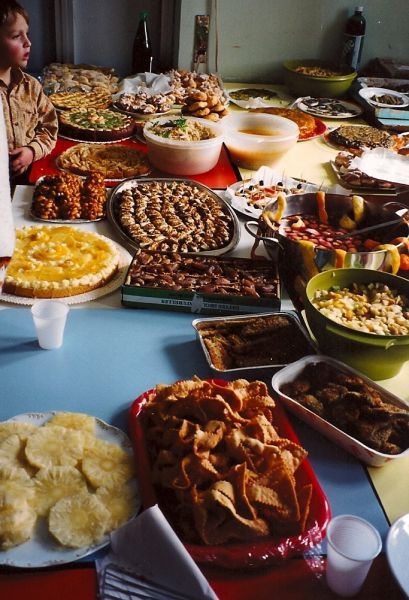St. Joseph Day in Sicily
In the heart of Sicily, the Marchesa Anna Tasca Lanza runs a cooking school at Regaleali, her family’s wine estate. Anna is also a cook book author: The Heart of Sicily and The Flavors of Sicily are two of her books. We were fortunate enough to visit there a few years ago for a week that included March 19, St. Joseph’s Day. Anna’s father, the Count Tasca d’Almerita, who has since passed away, was named Joseph, and I knew there would be a great celebration. In Southern Italy, the feast day of the saint for whom you were named, is celebrated like a birthday.
St Joseph’s day brings the hope of spring and a break from Lent for the Sicilians. San Giuseppuzzu as he is known to the Sicilians is much loved. He is the patron of the poor, the needy, and the orphaned and the celebration of his day in unlike any other in Sicily.
Anna suggested that we go to Salemi, a small town in the Belice Valley (about 50 miles southwest of Palermo) to see the bread altars especially constructed for this occasion. Our guide was the author Mary Taylor Simeti (Pomp and Sustenance and On Persephone’s Island). Mary came to Sicily in 1962, married a Sicilian and now she and her husband have a small farm and winery out side of Palermo.
In Salemi as elsewhere in Sicily, the central element on the feast of San Giuseppe is bread. We first went to see the official town altar. It was very elaborate and I will leave it up to Mary to describe: “the altar is placed within a most extraordinary bower, constructed of poles covered with myrtle branches, decorated with oranges and lemons , and hung with hundreds of little breads… fashioned into a flower, a beast, a saint; roses, daisies, and fava beans in their pods; butterflies, birds, and fish; even St Joseph himself, the bread of his monk’s habit colored dark brown by cocoa added to the dough.”
This bread is not meant to be eaten and the women of the town begin making the decorations for the next year right after this year’s celebration. In fact the whole town was covered with the bread figures.
Of course, bread for eating in all shapes and sizes is always present on St. Joseph’s Day. In her book On Persephone’s Island, Mary wrote “… on St Joseph’s Day the central element is the bread. Mainstay of the peasant diet and fruit of the island’s principal crop, bread is always sacred, so much so that according to an old superstition he who allows a crumb to fall on the floor will be condemned in the afterworld to gathering it up with his eyelashes”.
The town officials of Salemi invited us to an elementary school where a St Joseph Day celebration was taking place. There was a small altar, bread hanging everywhere, and a lot of food. Children dressed as Mary, Joseph and Jesus were at the center of the celebration. No one was allowed to eat until the Holy Family arrived.
The next day we went with Anna to the village nearest to Regaleali, Vallelunga, to see the St. Joseph Tables set up in some of the homes. People who choose to set up these tables do so to thank the saint for prayers that have been answered, for example, a loved one’s recovery from an illness. Platters filled with fried seasonal vegetables, meats, pastries, cookies, and pitchers of wine and other beverages cover long tables. There is a sense of competition between one home and another, and pride as to which family has the best St Joseph Table.
When we asked why certain foods were included, the answer was always “my mother or my grandmother did it this way”. In one house we commented on the St Joseph Table of a neighbor. We got a cold look, and the comment, ”they buy most of their food, everything here is home made”.
The night before St. Joseph’s Day we were invited for dinner at the Case Grande, the Count’s home. We walked there from the Casa Vecchia, where Anna lives and saw a big bonfire in the nearby field, symbolizing the preparation of the new crop and the coming of spring. The meal was prepared by a monsu, the Sicilian name for a French trained chef, and included many of the old Count’s favorite dishes, such as Duck a l’Orange.
The next day, St Joseph’s Day itself, big tables were set up in the count yard of the Casa Grande. Large pits were dug, fires set in them and they were covered with grills. We started with several kinds of arancini, rice balls filled with meat and peas or ham and béchamel as well as fried pasta timballeti, something like fried macaroni and cheese. Next we ate the grilled foods, including stigghiole, lambs intestines seasoned with scallions and pecorino and wrapped around a skewer, artichokes, sausages, chicken and lamb. Pasta con le Sarde and macco (dried fava beans) rounded out the menu. We drank Nozze d’Oro a white wine made from Inzolia and Sauvignon Tasca (a special clone of Sauvignon Blanc). The red wine was Rosso del Conte made mostly from old vine Nero d’Avola. For dessert we had Sfinci di San Giuseppe (St Joseph Fritters). For a recipe, go to my wife’s blog www.MicheleScicolone.com. It was a great St. Joseph’s day celebration with family and friends. We ate and drank all day, and the evening culminated with spectacular fireworks that lit up the night sky.




